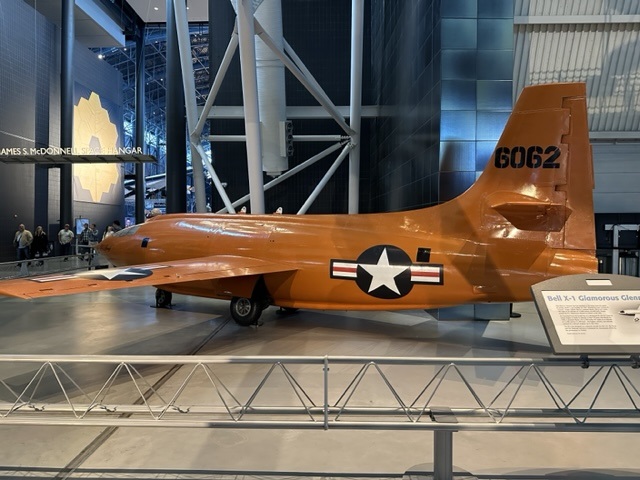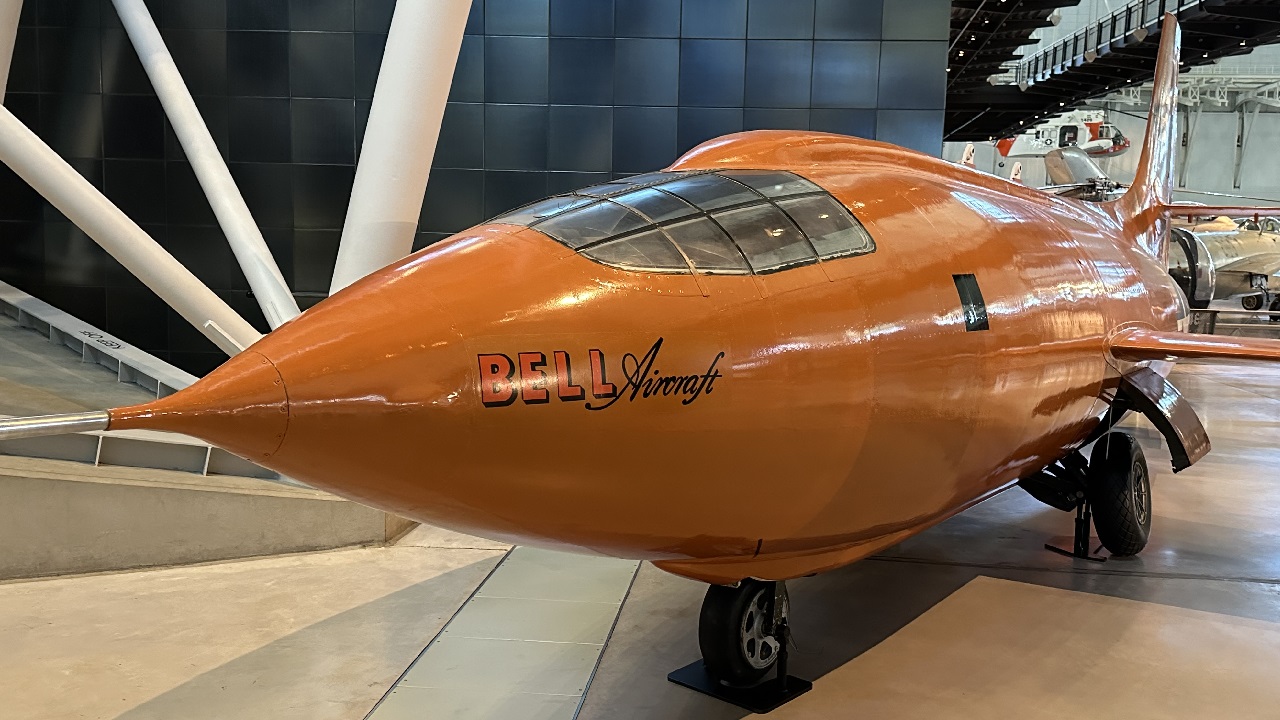Last year, On 18 September 2022, the United States Air Force proudly celebrated her 75th Birthday.
Fast forward to 14 October 2022, and the 75th anniversary of another military aviation milestone took place: that of then-Capt. (eventually Brig, Gen, USAF, Ret.) Chuck Yeager’s breaking of the sound barrier.
As Chuck Yeager was one of my boyhood heroes, I think this is an appropriate time to write about the plane in which Chuck pulled off the achievement, the Bell X-1 rocket plane (see our video below as we were able to check out up close the Bell X-1).
Bell X-1 History and Technical Specifications
The X-1 was manufactured by the Bell Aircraft Corporation – now known as Bell Textron – which had already made a name for itself in the military aviation community by building America’s jet-powered airplane, the P-59 Airacomet, back in 1943. The X-1 made her maiden flight on 19 January 1946, and a total of 7 airframes were built. Development actually began whilst WWII was still underway, i.e. on 16 March 1945, at the behest of the US Army Air Forces (USAAF) and the National Advisory Committee for Aeronautics (NACA – now NASA); Bell initially dubbed the experimental aircraft the XS-1 (Experimental, Supersonic). As noted by military history Kennedy Hickman of ThoughtCo, “In seeking inspiration for their new aircraft, the engineers at Bell elected to use a shape similar to a Browning .50-caliber bullet. This was done as it was known that this round was stable in supersonic flight.”
In essence, the X-1 was a single engine, single seat, mid-wing rocket plane with international orange paint scheme. The plane has a fuselage length of 31 feet, a wingspan of 22 feet 10 inches, a height of 10 feet 10 inches, an empty weight of 6,850 pounds, and a fully-laden weight of 14,750 pounds.
Brief Bio of Chuck Yeager
Charles Elwood Yeager was born on 13 February, 1923 in Myra, West “by God” Virginia and passed away on 7 December 2020 in Los Angeles, California, His military career began as an enlisted aircraft mechanic with the USAAF in 1941 before entering enlisted pilot training in September 1942 and graduating with the rank of flight officer (the USAAF equivalent of a warrant officer). He initially flew the Bell P-39 Airacobra – Chuck was among the few American aviators who actually liked that particular warbird – before transitioning to the P-51D Mustang, whereupon he truly made a name for himself: scoring 11.5 air-to-air kills, including 5 victories in a single day to achieve “ace in a day” status, and even managed to shoot down a Messerschmitt 262 Schwalbe (“Swallow”) jet, the world’s first operational jet fighter. Eventually Yeager earned commissioned officer status, continuing his military career after the war, becoming a test pilot, and thus positioning himself to make history in the X-1.
Breaking the Barrier
Chuck Yeager’s achievement is even more remarkable when you consider that he pulled off the feat with two broken ribs sustained when he was thrown from his horse two days prior! Luckily, as he explained in his bestselling 1986 autobiography, “Squeezed in there, my knees were higher than my shoulders, and my feet rested on the X-1 rudder pedals. I drove with an H-shaped control wheel on which the rocket thrusters and key instrumentation switches were located, I didn’t have to move my hands at critical moments, which is the reason I was able, later on, to fly with broken ribs.”
Just as he had done with his P-51 during the war, Yeager named his X-1“Glamorous Glennis” in honor of his wife. On that Earth-shattering (or sound-shattering, if you prefer) day, a B-29 Superfortress took off from Edwards AFB with Chuck and “Glamorous Glennis” ensconced in the bomb bay. The B-29 ascended to 23,000 feet before launching the rocket plane and her intrepid pilot, at which point Capt. Yeager employed the rocket engine to the operational altitude of 45,000 feet above the Rogers Dry Lake of the California Mojave Desert. Yeager and “Glennis” achieved history by hitting a speed of Mach 1.06 (700 mph/1,127 kph).
However, the actual experience itself felt a tad bit anticlimactic to Chuck: “And that was it. I sat up there feeling kind of numb, but elated. After all the anticipation to achieve this moment, it really was a let-down. It took a damned instrument meter to tell me what I’d done. There should’ve been a bump on the road, something to let you know you had just punched a nice clean hole through that sonic barrier. The Unknown was a poke through Jello. Later on, I realized that this mission had to end in a let-down, because the real barrier wasn’t in the sky, but in our knowledge and experience of supersonic flight.”
Chuck had a stellar career from there, attaining the rank of Brigadier General in 1969 before retiring in 1975 and then finding a second career as a spokesperson for AC Delco, the National Rifle Association (NRA), and a bestselling author. “Glamorous Glennis,” meanwhile, is displayed temporarily at the Smithsonian Air & Space Museum’s Steven F. Udvar-Hazy Center, and will return to display at the Museum in Washington, DC in the Boeing Milestones of Flight Hall later in their renovation project.
19FortyFive Visited the Bell X-1 in Washington, DC

Bell X-1. Photo Taken on October 1, 2022, at National Air and Space Museum. Image Credit: 19FortyFive.com
Christian D. Orr is a former Air Force Security Forces officer, Federal law enforcement officer, and private military contractor (with assignments worked in Iraq, the United Arab Emirates, Kosovo, Japan, Germany, and the Pentagon). Chris holds a B.A. in International Relations from the University of Southern California (USC) and an M.A. in Intelligence Studies (concentration in Terrorism Studies) from American Military University (AMU). He has also been published in The Daily Torch and The Journal of Intelligence and Cyber Security. Last but not least, he is a Companion of the Order of the Naval Order of the United States (NOUS). In his spare time, he enjoys shooting, dining out, cigars, Irish and British pubs, travel, USC Trojans college football, and Washington DC professional sports.

